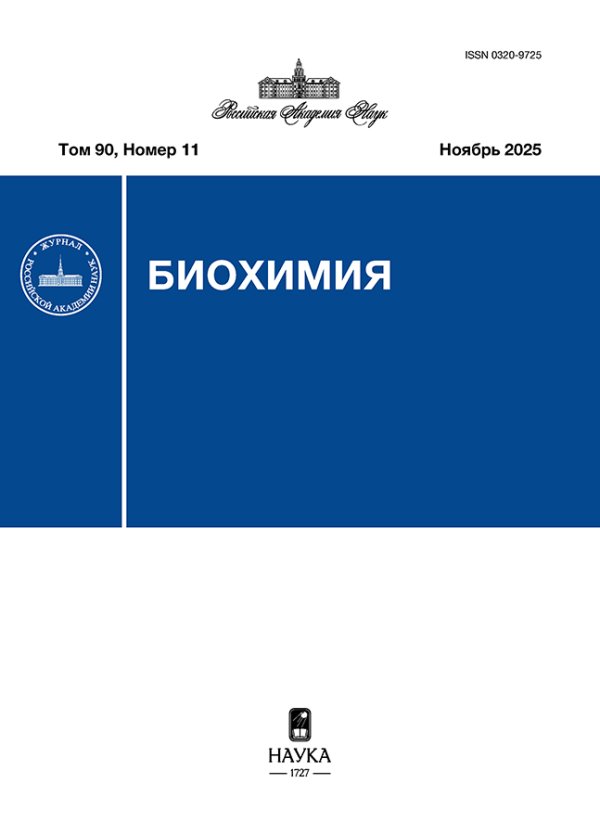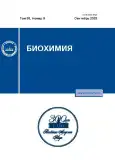Повышение уровня синтеза белка YciM позволяет снизить загрязнение эндотоксинами рекомбинантных белков, получаемых в Escherichia сoli
- Авторы: Бобровский П.А1,2, Харлампиева Д.Д1, Кириллин С.А1, Бровина К.А1,2, Графская Е.Н1, Лазарев В.Н1,2, Манувера В.А1,2
-
Учреждения:
- Федеральный научно-клинический центр физико-химической медицины имени академика Ю.М. Лопухина Федерального медико-биологического агентства
- Московский физико-технический институт (национальный исследовательский университет)
- Выпуск: Том 88, № 9 (2023)
- Страницы: 1597-1605
- Раздел: Статьи
- URL: https://journals.rcsi.science/0320-9725/article/view/141490
- DOI: https://doi.org/10.31857/S0320972523090117
- EDN: https://elibrary.ru/WUMDOY
- ID: 141490
Цитировать
Полный текст
Аннотация
Ключевые слова
Об авторах
П. А Бобровский
Федеральный научно-клинический центр физико-химической медицины имени академика Ю.М. Лопухина Федерального медико-биологического агентства;Московский физико-технический институт (национальный исследовательский университет)119435 Москва, Россия;141701 Долгопрудный, Московская обл., Россия
Д. Д Харлампиева
Федеральный научно-клинический центр физико-химической медицины имени академика Ю.М. Лопухина Федерального медико-биологического агентства119435 Москва, Россия
С. А Кириллин
Федеральный научно-клинический центр физико-химической медицины имени академика Ю.М. Лопухина Федерального медико-биологического агентства119435 Москва, Россия
К. А Бровина
Федеральный научно-клинический центр физико-химической медицины имени академика Ю.М. Лопухина Федерального медико-биологического агентства;Московский физико-технический институт (национальный исследовательский университет)119435 Москва, Россия;141701 Долгопрудный, Московская обл., Россия
Е. Н Графская
Федеральный научно-клинический центр физико-химической медицины имени академика Ю.М. Лопухина Федерального медико-биологического агентства119435 Москва, Россия
В. Н Лазарев
Федеральный научно-клинический центр физико-химической медицины имени академика Ю.М. Лопухина Федерального медико-биологического агентства;Московский физико-технический институт (национальный исследовательский университет)119435 Москва, Россия;141701 Долгопрудный, Московская обл., Россия
В. А Манувера
Федеральный научно-клинический центр физико-химической медицины имени академика Ю.М. Лопухина Федерального медико-биологического агентства;Московский физико-технический институт (национальный исследовательский университет)
Email: vmanuvera@yandex.ru
119435 Москва, Россия;141701 Долгопрудный, Московская обл., Россия
Список литературы
- Raetz, C. R., and Whitfield, C. (2002) Lipopolysaccharide endotoxins, Annu. Rev. Biochem., 71, 635-700, doi: 10.1146/annurev.biochem.71.110601.135414.
- Bos, M. P., Robert, V., and Tommassen, J. (2007) Biogenesis of the gram-negative bacterial outer membrane, Annu. Rev. Microbiol., 61, 191-214, doi: 10.1146/annurev.micro.61.080706.093245.
- Yoon, S. H., Jeong, H., Kwon, S. K., and Kim, J. F. (2009) Genomics, Biological Features, and Biotechnological Applications of Escherichia coli B: "Is B for better?!", in Systems Biology and Biotechnology of Escherichia coli (Lee, S. Y., ed), Springer, Dordrecht, doi: 10.1007/978-1-4020-9394-4_1.
- Mamat, U., Wilke, K., Bramhill, D., Schromm, A. B., Lindner, B., Kohl, T. A., Corchero, J. L., Villaverde, A., Schaffer, L., Head, S. R., Souvignier, C., Meredith, T. C., and Woodard, R. W. (2015) Detoxifying Escherichia coli for endotoxin-free production of recombinant proteins, Microb. Cell Fact., 14, 1-15, doi: 10.1186/s12934-015-0241-5.
- Kayagaki, N., Wong, M. T., Stowe, I. B., Ramani, S. R., Gonzalez, L. C., Akashi-Takamura, S., Miyake, K., Zhang, J., Lee, W. P., Muszyński, A., Forsberg, L. S., Carlson, R. W., and Dixit, V. M. (2013) Noncanonical inflammasome activation by intracellular LPS independent of TLR4, Science, 130, 1246-1249, doi: 10.1126/science.1240248.
- Park, B. S., Song, D. H., Kim, H. M., Choi, B. S., Lee, H., and Lee, J.-Oh (2009) The structural basis of lipopolysaccharide recognition by the TLR4-MD-2 complex, Nature, 458, 1191-1195, doi: 10.1038/nature07830.
- Mahalakshmi, S., Sunayana, M. R., Saisree, L., and Reddy, M. (2014) YciM is an essential gene required for regulation of lipopolysaccharide synthesis in Escherichia coli, Mol. Microbiol., 91, 145-157, doi: 10.1111/mmi.12452.
- Jiang, Y., Chen, B., Duan, C., Sun, B., Yang, J., and Yang, S. (2015) Multigene editing in the Escherichia coli genome via the CRISPR-Cas9 system, Appl. Environ. Microbiol., 81, 2506-2514, doi: 10.1128/AEM.04023-14.
- Klock, H. E., and Lesley, S. A. (2009) The Polymerase Incomplete Primer Extension (PIPE) method applied to high-throughput cloning and site-directed mutagenesis, Methods Mol. Biol., 498, 91-103, doi: 10.1007/978-1-59745-196-3_6.
- Dower, W. J., Miller, J. F., and Ragsdale, C. W. (1988) High efficiency transformation of E. coli by high voltage electroporation, Nucleic Acids Res., 16, 6127-6145, doi: 10.1093/nar/16.13.6127.
- Cormack, B. P., Valdivia, R. H., and Falkow, S. (1996) FACS-optimized mutants of the green fluorescent protein (GFP), Gene, 173, 33-38, doi: 10.1016/0378-1119(95)00685-0.
- Mamat, U., Woodard, R. W., Wilke, K., Souvignier, C., Mead, D., Steinmetz, E., Terry, K., Kovacich, Ch., Zegers, A., and Knox, C. (2013) Endotoxin-free protein production - ClearColiTM technology, Nat. Methods, 10, 916, doi: 10.1038/nmeth.f.367.
Дополнительные файлы










